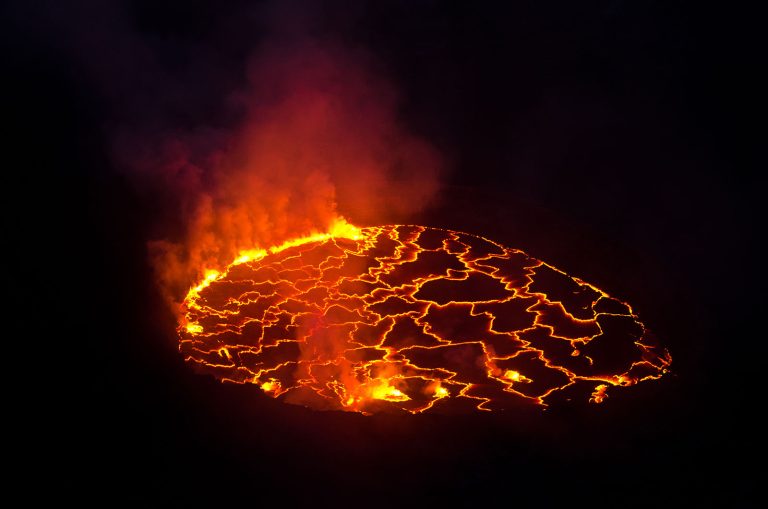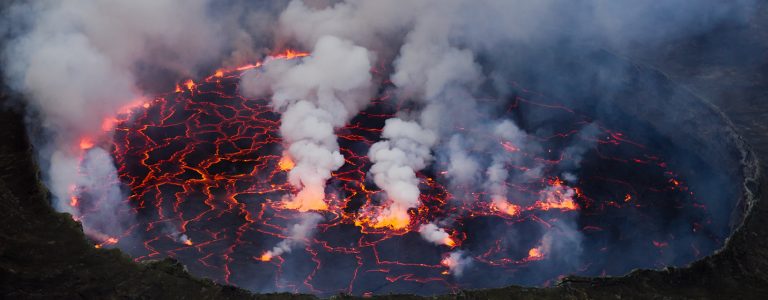Complete Guide to Virunga National Park
Welcome to the Virunga National Park Guide, a complete resource for visitors looking for information about the Virunga National Park, in Eastern Congo. This website is equipped with information, maps, guides, photos and links to some of the best resources to help you plan your trip to the Virunga National Park in the Democratic Republic of Congo. Let this guide help you plan your adventure to one of these amazing places on planet earth. Find out the best things to do, must see attractions, where to stay including safari lodges and exclusive tips to guide you in planning a gorilla trek in the park. Would you like to explore the park on an organized tour? We have listed the best tour operators and travel agents to book with a gorilla safari to Congo.
About Virunga National Park
Virunga National Park is Africa’s oldest protected area and it is the second oldest in the world (after Yellowstone). The park was gazetted in 1925 by the Belgian Colonial government and took the name of Albert National Park, named after the King Albert who was by then the king of Belgium. After Congo attaining its independence, it ‘s name was changed to Virunga National Park.
Occupying 1.2 million acres, Virunga National Park is rich in flora and fauna – home to 220 species of mammals and more than 700 bird species, the highest number of any protected area in Africa. This is one of the world’s most bio-diverse areas and it has been a UNESCO-designated World Heritage Site since 1979. Virunga National Park lies in the eastern mountains of the Congo, and it occupies some parts of the Virunga Mountains. The park extends northwards to the the Rwindi Plains, Lake Edward and the Rwenzori Mountains in the far north. It shares borders with the Volcanoes National Park in Rwanda, Mgahinga National Park and the Rwenzori Mountains National Park in Uganda.
The Virunga National Park is the best tourism destination in the Democratic Republic of Congo (DRC) with a great variety of unique natural, historical, cultural and heritage features which all provide travelers with great and memorable experience.
The national park covers the western shores of Lake Edward, known for its hippopotami while elsewhere, marshland, grassland plateau and plains dominate the park.
The Ruwenzori Mountains lie on the Ugandan border and rise to alpine meadows and a glacier, while Nyiragongo and Nyamuragira are both active volcanoes with substantial associated lava plains.
The park is managed by the Congolese National Park Authorities, the Institut Congolais pour la Conservation de la Nature (ICCN) and receives vital funding from the European Union.
Featured Congo Tours
At Virunga National Park, Africa’s oldest national park, you are invited to experience the best of gorilla trekking, mountain hiking and more adventures!
Things to See in Virunga Park
The Democratic Republic of Congo’s biggest single draw is this superb national park – the first in Africa – which has been rejuvenated in recent years to of fer a superb range of attractions.
The Virunga National Park is internationally recognized for its great attractions and biological diversity. Though the park is most famous for hosting the endangered mountain gorillas, it is rich in wildlife.
The 7,800-square-kilometre park contains rare species of animals including the critically endangered mountain gorillas only found in three countries in the world. There are also other animals in the park like chimpanzee, elephants, leopard, monkeys, and many others as well as several bird species. Read More
Mountain Gorillas
The Virunga National Park is home to approximately 280 of the world’s remaining 1060 Mountain Gorillas. The park’s gorillas live in the Mikeno Sector, an area of forest situated on the flanks of a range of mostly dormant volcanoes.
A Mountain Gorilla family, which can number from four to fifty individuals, is led by a single dominant adult male known as the “Silverback”, a name derived from the grey hair that develops on a male’s back as it reaches adulthood. The Silverback is responsible for protecting the family from predators or other threats, including solitary Silverbacks intent on claiming females as their own.
Some families contain more than one Silverback, but only one is dominant and that male alone is responsible for mating with the adult females of the group.
Despite all the lore about the ferocity of the mountain gorilla, in general they are very peaceful creatures. Most days are spent foraging for food, playing, and grooming. Aside from mock fighting amongst juveniles, displays of aggression are reserved for challenges to the Silverback’s dominance or direct threats to the family’s well being.
Other Primates
Primates –a total of 22 primate species survive in the Virunga Park, and aside from mountain gorillas, visitors stand a chance to see other unique primates. These include chimpanzees, olive baboons, Dent’s Mona monkeys, grey-cheeked mangabeys, De Brazza monkeys, Central African red colobus monkeys, black and white colobus monkeys, Hamlyn’s monkeys, blue monkeys and others.
Other Wildlife
The park also supports buffaloes, bush squirrels, African leopards, aardvarks, marsh mongoose, Nile crocodiles, scaly tailed squirrels, giant forest hogs, okapis, yellow backed duikers, porcupines, bush bucks, topis and more.
The reclusive endangered Okapi giraffe lives in the northern section of the park, the mountain gorillas in the south, the elephants occupy the eastern areas of the park and the chimpanzees in the South
Birds
An estimate of about 706 species of avifaunal species survive within the Virunga National Park. These include the Rwenzori turacos, double-toothed barbets, black thirsted wattle eye, Madagascar bee-eaters, narrow-tailed starling, African goshawk, red-throated alethe, white-headed wood hoopoe, strange weavers, black billed turacos, thick billed seed eaters to mention but a few.
Things to Do in Virunga Park
There are several things to do in the Virunga National Park. From the popular gorilla treks and hikes the Nyiragongo Volcano to bird watching, there are interesting activities to do in the Virunga.
Most trips to the Virunga are normally focused on visits to the multiple groups of habituated mountain gorillas within the park, as well as to do the magnificent hike to the top of the active Nyiragongo volcano, where you can stare down into a bubbling lava lake in the mas- sive crater below. However, there are many other activities on offer, including chimp treks, mountain climbing and bird watching. This is Africa’s hauntingly beautiful, beating heart and rarely is it possible to recommend somewhere so full heatedly.
Gorilla Trekking in Virunga
Virunga National Park is a beautiful park lying in the Eastern D.R. Congo. This designated UNESCO Heritage Site is home 8 habituated gorilla families and include Humba, Rugendo, Nyakamwe, Lulengo, Kabirizi, Munyanga, Mapuwa and Bageni gorilla families.
Trekking with the Virunga NP mountain gorillas can last for 2 to 6 hours inclusive of an hour of up close and personal with these large apes. The gorilla permits for Virunga gorilla trekking are issued at USD 450 per visitor. The treks begin with briefing at Bukima Patrol Post, and park ranger guides are allocated to every group of 8 tourists.
Currently, Virunga National park is very conducive and safe for gorilla tracking tours, with the established security in the area and conservation of the Mountain Gorillas. There are six families of the mountain gorillas habituated for tourist visits.
Virunga National Park Planner
Planning to take a tour to the Virunga National Park? Would you like to go an unforgettable safari to Virunga National Park but don’t know how to go about it or where to start from? As one of the oldest and most endowed National Parks in the Democratic Republic of Congo and Africa, you can never suffer from shortage of remarkable thing to see and do during your trip. However, the question is how can someone make the best pick for things to do in the shortest time possible?
Therefore, our comprehensive guide to visiting Virunga National Park covers required information on the safari destination, the must-do things and maybe some itinerary recommendations. This guide also provides information on the different places of lodging, best time to explore the outstanding Virunga National Park and getting there. The following quick links will get you started:
Getting Here – Where is the Virunga National Park? How do I get there?
Accommodation – Where should I stay? In the park or outside?
Attractions – What is there for me to see and do?
Packing for a Safari – What should I bring? What clothing for the climate?
Touring the Park – Guided Tours, Are there maps and guides available?
When is the Best Time to Visit Virunga National Park
A visit to DRC has no specific time since all seasons occur in different months. Around the tropical area north of the Equator, a dry spell begins from December to February. In the south, it starts from June to August and as you go to extreme south, the area experiences the least rain fall amount with some warmth around May, September and October. Around the Equatorial region, rains are experienced through out the year but they reduce around January to February and June to July.
How to Get to Virunga National Park
The Virunga National Park is situated West of Goma Town, the capital of North Kivu province. If you are in Rwanda, the Virunga perfectly accessed by road and it takes a visitor about 3 hours to drive from Kigali to Goma (Gisenyi) at the border of DRC. The road infrastructures are well developed to facilitate your movement. Goma Town is also accessible from South-Western Uganda at the border crossing area of Bunagana where the tourist can be in position to obtain a local visa for crossing. The earlier you arrange to get the visa, the better because it might cost you around $280 to purchase it at the border. However, Congo visas are obtainable at $100!
As well, tourists can fly into Goma town because there are several flights that can help to connect visitors to Goma. However, the Virunga National Park is also working hard to establish a tourism visa which is expected cost $50 and tourists will obtain it together with a Virunga National Park permit.
Essentials for border crossing
Most tourists travel to the Virunga National Park from Kigali city, drive via Gisenyi town and this is 4 to 5 hours’ drive. Essentials that you will require for border crossing to the D.R. Congo include valid yellow fever vaccination certificate, visas, and passports. Note, before traveling to Virunga NP be certain of the current security of the area and this is why you must keep in touch with your local tour operator on the ground for up-to-date information.
What to pack for a Trip to Virunga National Park
If you are planning to visit Virunga National Park, it is advisable to bring sunscreen, re-usable water bottle, a good camera or smart phone for photography, comfortable clothing and layers for the changing weather conditions, comfortable and lightweight safari pants for guided walks through the Park, Lightweight and breathable rain jacket, pajamas, wide brim hat, long-sleeved shirt, pair of binoculars, sunglasses, gardening gloves, a backpack, first aid kit and so much more.
Tour Operators
Getting around the DRC can be a slog. The transport network is virtually nonexistent, there are danger areas to be avoided and even getting a visa can give you a migraine. So no surprise, then, that some travellers find it easier to just let someone else organise everything for them.
The following tour companies are highly rec- ommended and can help with everything from obtaining a visa to organising a full expedition down the Congo River.
Accommodation
All accommodation inside the national park is run by ICCN. Most budget travellers base themselves in Goma and travel up to the park on day trips rather than spend the big bucks on the park lodge at Mikeno. Accommodation within the park works on a full-board system; day trippers should bring a packed lunch and plenty of water.
Mikeno Lodge
(Tel 0991715401; www.mikenolodge.com; s/d & tw incl meals US$316/450; pW ) Easily the most luxurious and beautifully designed hotel in DRC, Mikeno Lodge is a pampering slice of bliss in the wilds of the Congo jun- gle. Each of the 12 vast bungalows is made of dark volcanic stone, rich mahogany and beautifully crafted thatched roofs. Inside they boast a cosy lounge, open fire and a bathroom with a stone-lined shower.
Bukima Camp TENTED CAMP
(Tel 0991715401; www.visitvirunga.org; Bukima; s/d inc meals US$316/450) S This magical spot is also the departure point for many of Virunga’s gorilla-tracking excursions, which means you’ll be able to sleep later by staying here. The campsite consists of eight luxuri- ous tents with their own bathrooms, a large communal dining shelter and some stun- ning views towards the mountains.
Gorilla Trekking in Congo
Currently, Virunga National park is very conducive and safe for gorilla tracking tours, with the established security in the area and conservation of the Mountain Gorillas. There are six families of the mountain gorillas habituated for tourist visits.
Travel News & Advice
Check out the latest news, tips and travel updates from the Virunga National Park in Eastern DR Congo.

Gorilla Trekking in Uganda Vs Rwanda or DR Congo
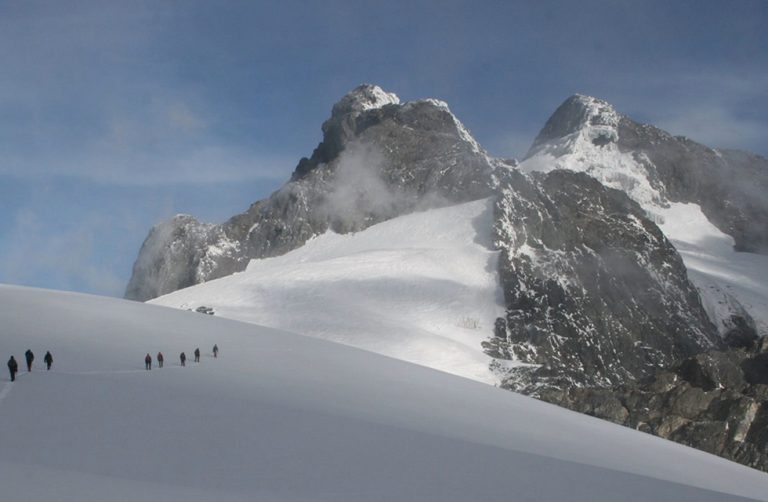
Visit Congo Gorillas and Hike the Rwenzoris
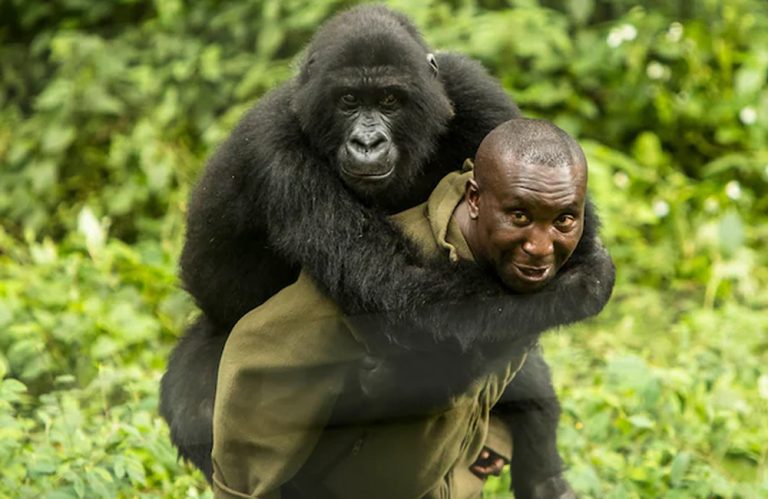
July 31st is World Ranger Day!
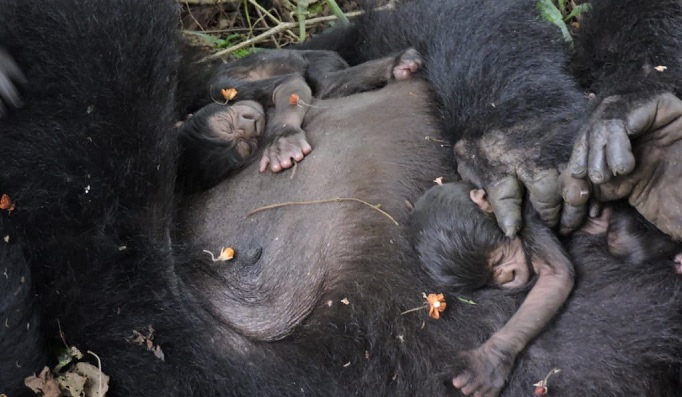
New Twin Baby Gorillas Born in Virunga National Park
Gorilla Trekking Safaris in Virunga
